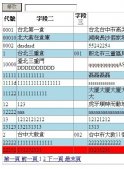主要目标
在Asp.net Core控制器中,通过自定义格式化程序来映射自定义处理控制器中的“未知”内容。本文将给大家详细介绍关于Asp.Net Core控制器接收原始请求正文内容的相关内容,分享出来供大家参考学习,下面话不多说了,来一起看看详细的介绍吧
简单案例
为了演示这个问题,我们用VS2017创建一个默认的Asp.net Core Web Api项目。
|
1
2
3
4
5
6
7
8
9
10
11
12
13
14
15
|
[Route("api/[controller]")][ApiController]public class ValuesController : ControllerBase{[HttpGet]public ActionResult<string> Get() { return "ok";}[HttpPost][Route("PostX")]public ActionResult<string> Post([FromBody] string value){ return value;}} |
Json请求
我们从最常见的json输入请求开始。
|
1
2
3
4
|
User-Agent: FiddlerHost: localhost:5000Content-Type: application/jsonContent-Length: 16 |
请求body:
|
1
|
{"123456"} |
通过后台调试和fiddler抓包,我们可以看到请求输入和返回。

后台调试,查看请求输入结果

fiddler查看请求header

fiddler查看返回结果
注意!!
别忘了[FromBody],有时候会忘的。
后台action接收类型为string的时候,请求body只能是字符串,不能传json对象。我演示这个例子时,被这点坑了。如果接收对象是一个类的时候,才可以传json对象。
没有JSON
虽然传输json数据是最常用的,但有时候我们需要支持普通的文本或者二进制信息。我们将Content-Type改为
text/plain
|
1
2
3
4
|
User-Agent: FiddlerHost: localhost:5000Content-Type:text/plainContent-Length: 16 |
请求body:
|
1
|
{"123456"} |
悲剧的事情来,报404!

不支持text/plain
事情到此就变得稍微复杂了一些,因为asp.netcore只处理它认识的类型,如json和formdata。默认情况下,原始数据不能直接映射到控制器参数。这是个小坑,不知你踩到过没有?仔细想想,这是有道理的。MVC具有特定内容类型的映射,如果您传递的数据不符合这些内容类型,则无法转换数据,因此它假定没有匹配的端点可以处理请求。
那么怎么支持原始的请求映射呢?
支持原始正文请求
不幸的是,ASP.NET Core不允许您仅通过方法参数以任何有意义的方式捕获“原始”数据。无论如何,您需要对其进行一些自定义处理Request.Body以获取原始数据,然后对其进行反序列化。
您可以捕获原始数据Request.Body并从中直接读取原始缓冲区。
最简单,最不易侵入,但不那么明显的方法是使用一个方法接受没有参数的 POST或PUT数据,然后从Request.Body以下位置读取原始数据:
读取字符串缓冲区
|
1
2
3
4
5
6
7
8
9
|
[HttpPost][Route("PostText")]public async Task<string> PostText(){ using (StreamReader reader = new StreamReader(Request.Body, Encoding.UTF8)) { return await reader.ReadToEndAsync(); }} |
这适用于一下Http和文本
|
1
2
3
4
|
User-Agent: FiddlerHost: localhost:5000Content-Type: text/plainContent-Length: 6 |
要读取二进制数据,你可以使用以下内容:
读取byte缓冲区
|
1
2
3
4
5
6
7
8
9
10
|
[HttpPost][Route("PostBinary")]public async Task<byte[]> PostBinary(){ using (var ms = new MemoryStream(2048)) { await Request.Body.CopyToAsync(ms); return ms.ToArray(); // returns base64 encoded string JSON result }} |
查看执行结果

接收文本内容

接收二进制数据
HttpRequest静态扩展
如果你为了方便,写了很多HttpRequest的扩展,接收参数时,可以看起来更简洁一些。
|
1
2
3
4
5
6
7
8
9
10
11
12
13
14
15
16
17
18
19
20
21
22
23
24
25
26
27
28
29
30
31
32
33
34
35
36
37
38
39
40
41
42
43
|
public static class HttpRequestExtension { /// <summary> /// /// </summary> /// <param name="httpRequest"></param> /// <param name="encoding"></param> /// <returns></returns> public static async Task<string> GetRawBodyStringFormater(this HttpRequest httpRequest, Encoding encoding) { if (encoding == null) { encoding = Encoding.UTF8; } using (StreamReader reader = new StreamReader(httpRequest.Body, encoding)) { return await reader.ReadToEndAsync(); } } /// <summary> /// 二进制 /// </summary> /// <param name="httpRequest"></param> /// <param name="encoding"></param> /// <returns></returns> public static async Task<byte[]> GetRawBodyBinaryFormater(this HttpRequest httpRequest, Encoding encoding) { if (encoding == null) { encoding = Encoding.UTF8; } using (StreamReader reader = new StreamReader(httpRequest.Body, encoding)) { using (var ms = new MemoryStream(2048)) { await httpRequest.Body.CopyToAsync(ms); return ms.ToArray(); // returns base64 encoded string JSON result } } } } |
|
1
2
3
4
5
6
7
8
9
10
11
12
13
14
15
16
|
[HttpPost][Route("PostTextX")]public async Task<string> PostTextX(){ return await Request.GetRawBodyStringAsyn();}/// <summary>/// 接收/// </summary>/// <returns></returns>[HttpPost][Route("PostBinaryX")]public async Task<byte[]> PostBinaryX(){ return await Request.GetRawBodyBinaryAsyn();} |
自动转换文本和二进制值
上面虽然解决了原始参数转换问题,但不够友好。如果你打算像原生MVC那样自动映射参数的话,你需要做一些自定义格式化适配。
创建一个Asp.net MVC InputFormatter
ASP.NET Core使用一种干净且更通用的方式来处理内容的自定义格式InputFormatter。输入格式化程序挂钩到请求处理管道,让您查看特定类型的内容以确定是否要处理它。然后,您可以阅读请求正文并对入站内容执行自己的反序列化。
InputFormatter有几个要求
- 您需要使用[FromBody]去获取
- 您必须能够查看请求并确定是否以及如何处理内容。
在这个例子中,对于“原始内容”,我想查看具有以下类型的请求:
- text/plain(文本)
-
appliaction/octet-stream(byte[])
没有内容类型(string)
要创建格式化程序,你可以实现IInputFormatter或者从InputFormatter继承。
|
1
2
3
4
5
6
7
8
9
10
11
12
13
14
15
16
17
18
19
20
21
22
23
24
25
26
27
28
29
30
31
32
33
34
35
36
37
38
39
40
41
42
43
44
|
public class RawRequestBodyFormatter : IInputFormatter{ public RawRequestBodyFormatter() { } public bool CanRead(InputFormatterContext context) { if (context == null) throw new ArgumentNullException("argument is Null"); var contentType = context.HttpContext.Request.ContentType; if (string.IsNullOrEmpty(contentType) || contentType == "text/plain" || contentType == "application/octet-stream") return true; return false; } public async Task<InputFormatterResult> ReadAsync(InputFormatterContext context) { var request = context.HttpContext.Request; var contentType = context.HttpContext.Request.ContentType; if (string.IsNullOrEmpty(contentType) || contentType.ToLower() == "text/plain") { using (StreamReader reader = new StreamReader(request.Body, Encoding.UTF8)) { var content = await reader.ReadToEndAsync(); return await InputFormatterResult.SuccessAsync(content); } } if (contentType == "application/octet-stream") { using (StreamReader reader = new StreamReader(request.Body, Encoding.UTF8)) { using (var ms = new MemoryStream(2048)) { await request.Body.CopyToAsync(ms); var content = ms.ToArray(); return await InputFormatterResult.SuccessAsync(content); } } } return await InputFormatterResult.FailureAsync(); }} |
格式化程序用于CanRead()检查对内容类型的请求以支持,然后将ReadRequestBodyAsync()内容读取和反序列化为应在控制器方法的参数中返回的结果类型。
InputFormatter必须在ConfigureServices()启动代码中注册MVC :
|
1
2
3
4
|
public void ConfigureServices(IServiceCollection services) { services.AddMvc(o=>o.InputFormatters.Insert(0,new RawRequestBodyFormatter())).SetCompatibilityVersion(CompatibilityVersion.Version_2_1); } |
接受原始输入
|
1
2
3
4
5
6
|
[HttpPost][Route("PostTextPlus")]public string PostTextPlus([FromBody] string value){ return value;} |
然后你就可以发送post请求,像这样:
|
1
2
3
|
User-Agent: FiddlerHost: localhost:5000Content-Length: 6 |
或者
|
1
2
3
4
|
User-Agent: FiddlerHost: localhost:5000Content-Type:text/plainContent-Length: 6 |
请注意,您可以使用内容类型调用相同的控制器方法application/json并传递JSON字符串,这也将起作用。在RawRequestBodyFormatter 简单地增加它支持的附加内容类型的支持。
二进制数据
|
1
2
3
4
5
6
|
[HttpPost][Route("PostBinaryPlus")]public byte[] PostBinaryPlus([FromBody] byte[] value){ return value;} |
请求内容如下:
|
1
2
3
4
|
User-Agent: FiddlerHost: localhost:5000Content-Length: 6Content-Type: application/octet-stream |
源代码
示例代码已上传到 CsharpFanDemo
参考链接
本文包含翻译和自己实践。主要思路和代码来源于以下链接:
Accepting Raw Request Body Content in ASP.NET Core API Controllers
总结
以上就是这篇文章的全部内容了,希望本文的内容对大家的学习或者工作具有一定的参考学习价值,如果有疑问大家可以留言交流,谢谢大家对服务器之家的支持。
原文链接:https://www.jianshu.com/p/4a96d73428dc














